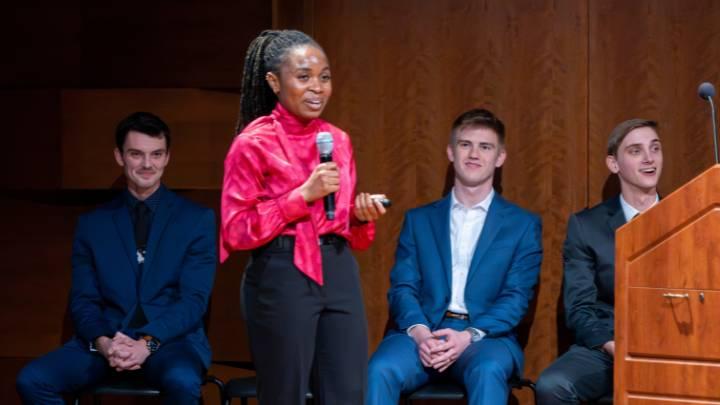Students create viable path for Calvin University to achieve carbon neutrality by 2030

Standing on stage in the CFAC Recital Hall at Calvin University, senior Stuart Johnston set the stage.
“In 2015, the Paris Agreement set the goal of limiting global warming to under 1.5 degrees Celsius. So why is 1.5 degrees Celsius significant?” Johnston asked. “Because this is the point where irreversible climate change will occur.”
While curbing this trajectory is not something any one organization can do on its own, each institution is responsible for doing its part. In 2017, then-president of Calvin University Michael Le Roy signed the President’s Climate Commitment, which pledged Calvin to becoming carbon neutral by 2057.
“This was a groundbreaking commitment and a great step in the right direction,” said Johnston. “But scientists right now are predicting that if the world continues with business as usual, we can expect to hit that 1.5-degree Celsius mark by 2030.”
Aiming higher
bodyimage1
It's within this context that current Calvin president Wiebe Boer posed the question: “What earlier year should Calvin University choose for its carbon neutrality date?”
And Boer turned to an internal consulting firm to discover the answer: Professor Matt Heun’s Engineering 333 classes.
Getting to work
This fall, students in each of his sections of ENGR 333 formed into four teams.
An electricity team, led by senior David Harris, was considering all of Calvin’s electricity needs and how it could become carbon neutral.
A heating team, led by senior Stuart Johnston, was figuring out how to heat all of Calvin’s campus with zero net carbon emissions.
An efficiency team, led by senior Panashe Makuvaro, was looking for ways to use electricity and heating more efficiently and at reducing the amount of waste both on the energy and the money side.
A funding team, led by senior Michael Lanning, was tasked with figuring out how much the path to carbon neutrality will cost and at finding creative ways to fund it.
bodyimage2
Turning ideas into solutions
The teams came up with lots of ideas throughout the semester, and, in December, Harris, Johnston, Makuvaro, and Lanning presented the team’s final recommendations.
“Initially, we were optimizing for energy and focusing on what’s going to reduce our carbon emissions by the most amount,” said Makuvaro, “but the final step was the funding, because that’s the biggest thing. It could be a good idea, but if you can’t fund it, then there’s no point in including it.”
At a public seminar, the team leads presented, one-by-one, tangible solutions to making Calvin carbon neutral, everything from installing geothermal ground source heat pumps and smart thermostats, to adding a solar farm to campus and buying carbon offsets.
bodyimage3
“After researching all of our projects and how we would implement them, it was remarkable to see how feasible they can be. They are not only carbon neutral, but they are also cash positive throughout the entire process,” said Harris.
Proposing a significant move
In the end, the team proposed moving Calvin’s carbon neutrality date up 27 years to 2030.
“We didn’t just pick that date because of the Paris Agreement” said Makuvaro. “We were fortunate enough with all our hard work and calculations. 2030 is what we saw as feasible.”
While there is a significant financial investment needed for projects that will move the university toward carbon neutrality, there is also a significant source of financial relief. When the team calculated in energy cost savings from now until 2030, considered tax credits and grants available and rebates allowable through the Inflation Reduction Act, the total cost to Calvin over the next six years would be around $7 million, most of which administrators think could be covered by donors.
“This project confirmed that students can actually do it,” said Makuvaro. “A lot of the time you think you are restricted to what’s in the textbook, what’s coming on the test, but getting the opportunity to look at real-life stuff makes you feel like an engineer before you get that certificate at graduation.”
Unparalleled experience
bodyimage4
“Our students continue to impress me with their ability to come up with creative solutions to some of the most complex problems,” said Wiebe Boer, president of Calvin University. “Their public presentation was both clear and comprehensive, and their critical thinking skills were on full display as we interacted throughout this semester.”
This fall, the class had more than a few touchpoints with President Boer, Vice President Dirk Pruis, Vice President for Advancement Greg Elzinga, and engineers from GMB. Every few weeks, the students would invite the client group into their class where they’d present their findings, allow for questions, and ask for feedback along the way.
“That’s the feedback they’ll get on the job when they present to potential funders or clients,” said Heun. “So, to have that opportunity in the classroom before they graduate is quite a unique and interesting experience for them.”
“Having all of those individuals in the room while we are giving our presentation gives us a sense of realism and a sense of importance of this project, that it is being valued by the administration,” said Harris.
Dreaming bigger
And the students also see how projects like these give them a glimpse of what’s possible.
bodyimage5
“I think a project like this certainly helps us acknowledge where things are going badly,” said Makuvaro, “but it also motivates us. I can wake up feeling like my work is contributing to something bigger than I am. I may not be a priest, and I may not be a pastor, but I’m still involved in making God’s world a better place.”
“Calvin has an opportunity to lead other universities and colleges by moving our date forward,” said Lanning. “We can improve our shared future, but it is imperative that we act soon.”






